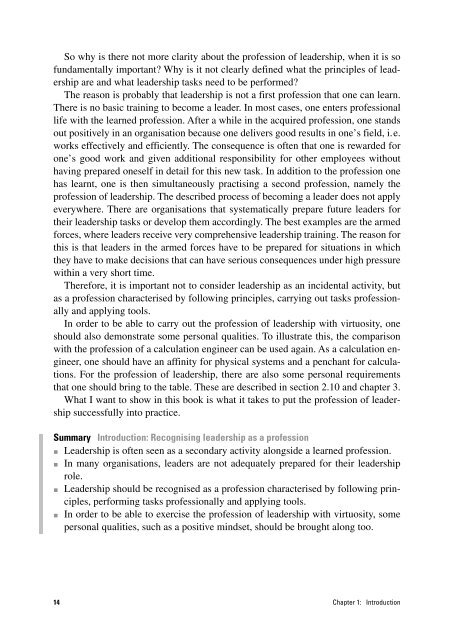Georg Kapeller: Success Factors of Leadership
- No tags were found...
You also want an ePaper? Increase the reach of your titles
YUMPU automatically turns print PDFs into web optimized ePapers that Google loves.
So why is there not more clarity about the pr<strong>of</strong>ession <strong>of</strong> leadership, when it is so<br />
fundamentally important? Why is it not clearly defined what the principles <strong>of</strong> leadership<br />
are and what leadership tasks need to be performed?<br />
The reason is probably that leadership is not a first pr<strong>of</strong>ession that one can learn.<br />
There is no basic training to become a leader. In most cases, one enters pr<strong>of</strong>essional<br />
life with the learned pr<strong>of</strong>ession. After a while in the acquired pr<strong>of</strong>ession, one stands<br />
out positively in an organisation because one delivers good results in one’s field, i.e.<br />
works effectively and efficiently. The consequence is <strong>of</strong>ten that one is rewarded for<br />
one’s good work and given additional responsibility for other employees without<br />
having prepared oneself in detail for this new task. In addition to the pr<strong>of</strong>ession one<br />
has learnt, one is then simultaneously practising a second pr<strong>of</strong>ession, namely the<br />
pr<strong>of</strong>ession <strong>of</strong> leadership. The described process <strong>of</strong> becoming a leader does not apply<br />
everywhere. There are organisations that systematically prepare future leaders for<br />
their leadership tasks or develop them accordingly. The best examples are the armed<br />
forces, where leaders receive very comprehensive leadership training. The reason for<br />
this is that leaders in the armed forces have to be prepared for situations in which<br />
they have to make decisions that can have serious consequences under high pressure<br />
within a very short time.<br />
Therefore, it is important not to consider leadership as an incidental activity, but<br />
as a pr<strong>of</strong>ession characterised by following principles, carrying out tasks pr<strong>of</strong>essionally<br />
and applying tools.<br />
In order to be able to carry out the pr<strong>of</strong>ession <strong>of</strong> leadership with virtuosity, one<br />
should also demonstrate some personal qualities. To illustrate this, the comparison<br />
with the pr<strong>of</strong>ession <strong>of</strong> a calculation engineer can be used again. As a calculation engineer,<br />
one should have an affinity for physical systems and a penchant for calculations.<br />
For the pr<strong>of</strong>ession <strong>of</strong> leadership, there are also some personal requirements<br />
that one should bring to the table. These are described in section 2.10 and chapter 3.<br />
What I want to show in this book is what it takes to put the pr<strong>of</strong>ession <strong>of</strong> leadership<br />
successfully into practice.<br />
Summary Introduction: Recognising leadership as a pr<strong>of</strong>ession<br />
<strong>Leadership</strong> is <strong>of</strong>ten seen as a secondary activity alongside a learned pr<strong>of</strong>ession.<br />
In many organisations, leaders are not adequately prepared for their leadership<br />
role.<br />
<strong>Leadership</strong> should be recognised as a pr<strong>of</strong>ession characterised by following principles,<br />
performing tasks pr<strong>of</strong>essionally and applying tools.<br />
In order to be able to exercise the pr<strong>of</strong>ession <strong>of</strong> leadership with virtuosity, some<br />
personal qualities, such as a positive mindset, should be brought along too.<br />
14 Chapter 1: Introduction
















